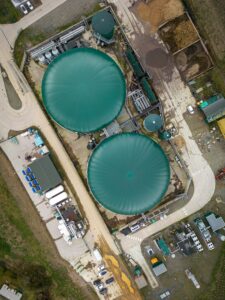EnviTec’s Bioenergie Park Güstrow is preparing for operation

The company is now ready to begin the plant's operation.
"Now that the last component, the 300,000-litre LCO2 tank made of pressure vessel steel, has been integrated, we can start the test phase with the newly installed plant components," said Frank Hinken, managing director of EnviTec Bioenergie Güstrow.
The raw biogas produced at BioEnergie Park Güstrow is upgraded to natural gas quality with the help of the EnviThan gas upgrading process.
The CO2-enriched permeate (exhaust air) from the gas treatment process contains an extremely small amount of methane and is transferred to the CO2 liquefaction plant (LCO2 plant) for further treatment. It is used for the production of liquid carbon dioxide.
'The bio-CO2 produced can be used in food and beverage production sectors, for example, or, in greenhouses," explained Hinken.
The off-gas created during the liquefaction of CO2, which contains other non-condensable gases such as nitrogen, oxygen and hydrogen as well as methane, is fed to the combined heat and power plants at the site, where it is used to generate energy for self-supply.
"Through this active circular economy, we are making an important contribution to a greener transport sector," commented Jürgen Tenbrink, chief technology officer of EnviTec Biogas, which is based in Lohne and Saerbeck.
Once in operation, set for late summer this year, the plant will produce 25,000 kg of bio-LNG daily for heavy-duty transport vehicles.
This will provide green fuel for more than 50,000,000 lorry kilometres (31,068,550 miles) per year, calculated the company.
At the same time, the liquefaction of biomethane is accompanied with the liquefaction of carbon dioxide via the gas treatment process. The liquid carbon dioxide, 15,000 metric tonnes per year generated at food quality, substitutes fossil-based carbon dioxide, significantly improving the CO2 footprint of the plant.


















